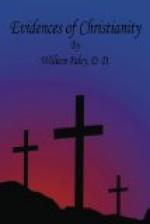SECTION I.
The historical books of the New Testament, meaning thereby the four Gospels and the Acts of the Apostles, are quoted, or alluded to, by a series of Christian writers, beginning with those who were contemporary with the apostles, or who immediately followed them, and proceeding in close and regular succession from their time to the present.
The medium of proof stated in this proposition is, of all others, the most unquestionable, the least liable to any practices of fraud, and is not diminished by the lapse of ages. Bishop Burnet, in the History of his Own Times, inserts various extracts from Lord Clarendon’s History. One such insertion is a proof that Lord Clarendon’s History was extant at the time when Bishop Burnet wrote, that it had been read by Bishop Burnet, that it was received by Bishop Burnet as a work of Lord Clarendon, and also regarded by him as an authentic account of the transactions which it relates; and it will be a proof of these points a thousand years hence, or as long as the books exist. Quintilian having quoted as Cicero’s, (Quint, lib. xl. c. l.) that well known trait of dissembled vanity:—“Si quid est in me ingenii, Judices, quod sentio quam sit exiguum;”—the quotation would be strong evidence, were there any doubt, that the oration, which opens with this address, actually came from Cicero’s pen. These instances, however simple, may serve to point out to a reader who is little accustomed to such researches the nature and value of the argument.
The testimonies which we have to bring forward under this proposition are the following:—
I. There is extant an epistle ascribed to Barnabas,* the companion of Paul. It is quoted as the epistle of Barnabas, by Clement of Alexandria, A.D. CXCIV; by Origen, A.D. CCXXX. It is mentioned by Eusebius, A.D. CCCXV, and by Jerome, A.D. CCCXCII, as an ancient work in their time, bearing the name of Barnabas, and as well known and read amongst Christians, though not accounted a part of Scripture. It purports to have been written soon after the destruction of Jerusalem, during the calamities which followed that disaster; and it bears the character of the age to which it professes to belong.
_________
* Lardner, Cred. edit. 1755, vol. i. p. 23, et seq. The reader will observe from the references, that the materials of these sections are almost entirely extracted from Dr. Lardner’s work; my office consisted in arrangement and selection. _________
In this epistle appears the following remarkable passage:—“Let us, therefore, beware lest it come upon us, as it is written; There are many called, few chosen.” From the expression, “as it is written,” we infer with certainty, that at the time when the author of this epistle lived, there was a book extant, well known to Christians, and of authority amongst them, containing these words:—“Many are called, few chosen.” Such a book is




